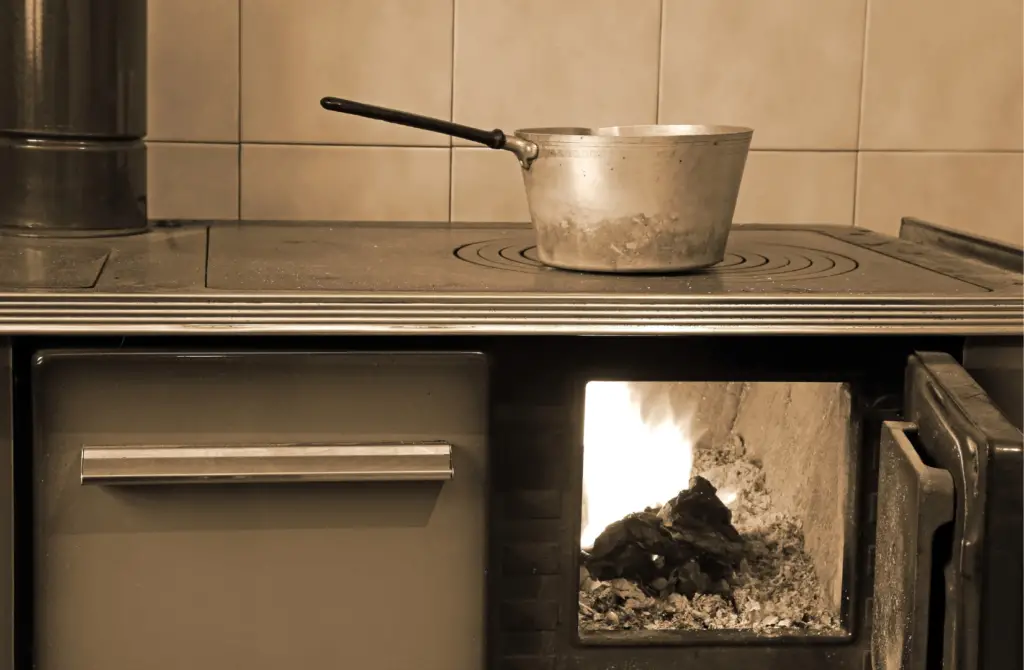Keeping a wood-burning stove in your kitchen sounds like a good idea, especially if you use the kitchen as a social space. But can a wood-burning stove go in the kitchen?
Yes, you can install a wood-burning stove in your kitchen. The stove must be connected to a functional flue system. There should be adequate clearance around the stove, and you must not turn on your kitchen extractor fan, which creates negative air pressure, when using the stove.
A wood-burning stove can provide warmth and become a focal point for all members of your family. However, there are some important things to keep in mind when putting the appliance in your kitchen. Keep reading to learn more.

Can I put a wood-burning stove in my kitchen?
Installing a wood-burning stove in the kitchen is a pretty good idea if your family members gather in the kitchen to relax and socialize.
Most traditional homes in cold regions have fireplaces. You can replace your fireplace with a wood-burning stove or install a stove in addition to your fireplace. A sophisticated modern wood-burning stove can add comfort and aesthetic appeal to your kitchen.
The installation of a wood-burning stove in a kitchen should be carefully planned, in part because kitchens tend to be smaller than other rooms. If there is no flue pipe in your kitchen, you will have to install one for your wood-burning stove. And in order to reduce air pollution inside the house, it’s important to clean the flue regularly.
The flue pipe can either run through a wall or go up through the kitchen. The exact procedure depends on the infrastructure of your kitchen.
Do I need a vent in a kitchen with a wood-burning stove?
Yes. All combustion-based appliances, including wood-burning and multi-fuel stoves, require a supply of air. And once the combustion has taken place, the gasses must be evacuated through a flue system.
If a wood-burner is installed without a flue system, combustion will take place for a short period and then smoke will fill the room. This, of course, is not what you want. A source of air is required for the continuous air movement through the chimney, which ensures that the smoke is released outside.
There is a simple way to know if the fire has adequate air supply. Just open a door or window and notice if there is any improvement in the size of the flame. If yes, your wood-burning stove needs better air ventilation.
In most places, building codes make it mandatory for newly built airtight properties to have air vents that are permanently open. You cannot close or cover it up. The system requires 50mm2 of ventilation for each KW output the appliance produces. So, if your stove is rated 5KW, your air vent aperture should measure 550mm2.
Old homes are not very airtight. If you are living in an old home with unsealed primary doors and exterior storm doors, you need a vent only if your wood-burning stove is rated more than 5KW.
And if you have an extractor fan in your kitchen, do not turn the fan on when the wood-burning stove is on. This is because the combustion of wood requires positive chimney pressure while extractor fans create negative pressure, making the chimney useless and filling the room with smoke.

How much clearance do you need around a wood-burning stove?
Prioritize safety when installing any combustion-based appliance. In general, building regulations recommend a clearance of at least 150 mm between a wood-burning stove and stone, tile, brick, or any non-combustible material. If you choose a fully-contained, modern wood-burning stove, leaving this little clearance is easy.
However, the clearance must be more than 150 mm when there are combustible materials around your stove. If you have a wooden mantlepiece, the distance between the hearth and the flue must be at least 3 times the diameter of your flue.
For example, if it is a 150 mm flue, make sure the mantlepiece is at least 450 mm away. You can reduce this requirement by installing a heat guard and twin-wall insulated system. It’s a pretty effective way to prevent the mantlepiece from catching fire.
There are guidelines for the hearth itself, too. The material of the hearth must be something non-combustible, such as stone, granite, or tiles. The clearance should also be determined by the size of your wood-burning stove.
If the hearth temperature does not exceed 100°C and the length of the hearth is at least 300 mm, keep a clearance of about 150 mm on each side of your wood-burning stove. In this case, a 12 mm-thick hearth should be enough.
But if the hearth temperature exceeds 100°C or if you don’t know if it will, make sure the thickness of the hearth is at least 250 mm. By ensuring this, you can prevent damage to the floor, particularly if it’s a wooden floor.
Can a wood-burning stove be close to a brick wall?
If the stove is close to a brick wall, the clearance between the stove and the wall can be as little as 25 mm because the brick wall is not flammable. There is little to no risk of a brick wall catching fire.
However, it is important to note that to some extent, the efficiency of a wood-burning stove depends on the air clearance around it. Less clearance can be a reason your stove is transferring less heat into the room.
Some modern wood-burning stoves are small but very efficient. Do a little bit of research and you may find a unit that perfectly fits in your old fireplace, with adequate clearance around the appliance. The manufacturer of your wood-burning stove may also provide guidelines for clearance.
What are the regulations for a wood-burning stove flue?
The diameter of the flue should be 25% larger than the diameter of the stove outlet that connects the appliance to the chimney. That means, if the diameter of your stove pipe is 8 inches, the setup requires a flue with a diameter of 10 inches.
Smoke moves up through a round flue more smoothly than through a rectangular or square one. This is because in a round flue, the swirling movement of the smoke has little to no obstruction. Also, a flue with a smooth inner surface works better than one with a rough inner surface.
Can you connect your wood-burning stove to an existing flue that vents another appliance? No, you cannot do that, according to the regulations specified by the National Fire Protection Association (NFPA). There must be a separate flue for each appliance (chimney flue article). It is to be noted here that there must be multiple flues in a chimney.
Can you have a wood-burning stove without a chimney?
If you are living in a modern home without a chimney, you can install a wood-burning stove. In such a case, you will have to get a twin wall chimney flue system installed. The system consists of some stainless steel pipes that carry the smoke outside.
A twin wall flue system can be installed internally or externally. The first method involves connecting the flue to your wood-burning stove and then running the flue through your ceilings. And the second method involves connecting the flue to your stove and then running the flue through an external wall.
Because an internal flue needs to be boxed up inside your kitchen, the system will take up more space. On the other hand, installing an external flue requires less work inside your kitchen, and the flue remains invisible.
Conclusion
You can install a wood-burning stove in your kitchen even if you do not have a particularly large kitchen. Combustion-based appliances, including wood-burning stoves, have come a long way in the past couple of decades. You can find a cute, small unit that fits nicely in your small kitchen, with adequate clearance around the appliance.
Your stove requires a supply of air for combustion and a flue system through which gasses can evacuate. Ensure them, and do not turn your extractor fan on when you are using your stove. Just follow some safety rules and you will get the best out of your wood-burning stove.
